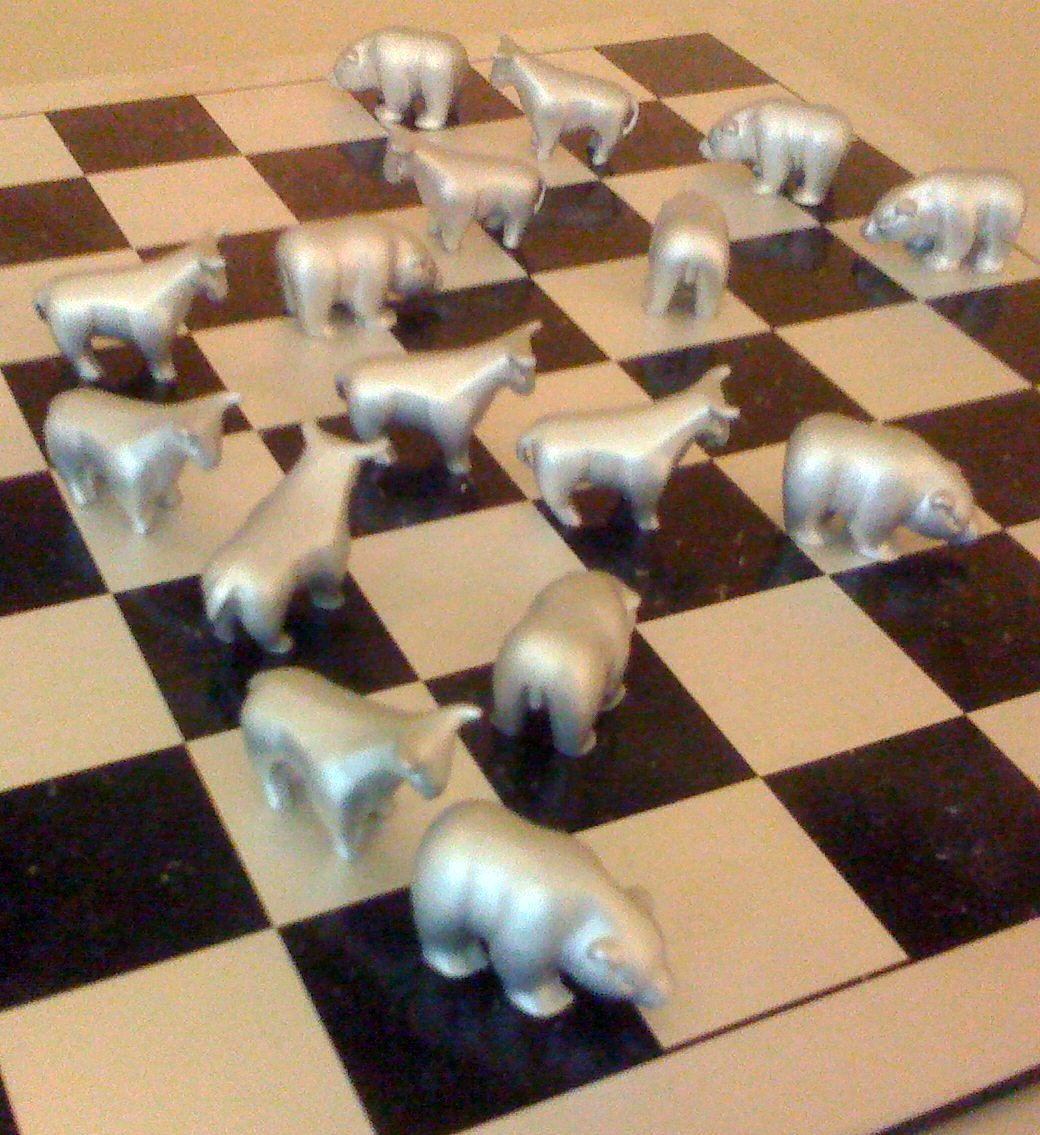December 19, 2012
 To profit when buying a stock, you must be right on the direction as soon as you enter the trade. If the stock goes up, you’ll make money, and if the stock goes down, you’ll lose money. If you short a stock, and the stock goes down, you’ll make money and if the stock goes up, you’ll lose money. Pretty basic, right?
To profit when buying a stock, you must be right on the direction as soon as you enter the trade. If the stock goes up, you’ll make money, and if the stock goes down, you’ll lose money. If you short a stock, and the stock goes down, you’ll make money and if the stock goes up, you’ll lose money. Pretty basic, right?
However, once I learned how options work and started to trade them many years ago, I realized Newton’s law of motion could allow me to profit regardless of whether a bullish trade went up, or a bearish trade went down.
To quote Isaac Newton, and I paraphrase, “A body in motion will remain in motion.” The Moses corollary to that would be: “A stock in a trend, will remain in a trend – until it isn’t.” And as long as it stays in that trend, there are numerous options strategies designed to take advantage of one of the attributes that make options unique: time decay.
This means it’s possible for a stock to go absolutely nowhere, or to even be wrong directionally on a stock/option trade, and still be able to profit. Now I don’t mean is Enron wrongÉ but it is possible to have a stock go against you directionally by 5%, sometimes even 10%, and still profit. This strategy can be accomplished by the buying and selling of out of the money options, which if they are still out of the money on their expiration date, will expire worthless (and traders would keep the premium sold).
Now while I can’t speak for everybody, the only reason I’m in the market, the only reason I’m a trader, is to… make a profit. So how liberating is it to know that you can profit, even when wrong on the direction your analysis suggested a stock would move in?
Here are 7 conservative options strategies designed to profit when stocks either go nowhere, stay above or below specified demand or supply levels, or stay within a defined range.. for approximately anywhere between three and six weeks:
1) Bull/Put Spread – You sell a put option at the strike price you expect the stock to stay above, and buy another put option at the next out of the money strike price.
2) Bear/Call Spread – You sell a call option at the strike price you expect the stock to stay under, and buy another call option at the next out of the money strike price.
3) Bull/Call Spread – You buy a call option, and sell another call option at a strike price you expect the stock to stay over.
4) Bear/Put Spread – You buy a put option, and sell another put option at a strike price you expect the stock to stay under.
5) Cash Secured Put – You sell a put option at a strike price you expect the stock to stay over.
6) Covered Call – On a stock you already own, you sell a call option at a strike price you expect the stock to stay under.
7) Iron Condor – You enter a bull/put spread and a bear/call spread at the same timeÉ looking to capture a range you expect the stock to stay in between.
Every option trade carries risk of loss, up to and including 100% of the principle invested.
This is a guest post by Steve Moses, Options Trader and Instructor at Online Trading Academy
Tags:
Cash Flow,
Currency,
economy,
money,
stock
May 21, 2012
Are you a Bull or a Bear? If you are a sports fan you may think I am talking about either of the professional sports teams in Chicago, but you would be wrong! What I am actually referring to is the type of investor you are when it comes to investing in the financial markets. For those of you that don’t know, the financial markets are classed as being either a bear market or a bull market, depending on the current economic state. A bear market occurs when there is a steady decline in the stock market and investors are less confident about future prospects of stocks causing their prices to continue declining. A bull market occurs when the opposite is happening, investor optimism and confidence would be high and the stock market in general would be on an incline/resurgence with prices steadily rising.
At this current moment the world financial markets are definitely in what can be classed as a bear market, as stock prices are low and investor confidence is at an all-time low. This of course is because of the global recession that we are currently facing, which appears as If it will remain this way for the near future. Investors are really suffering because of this, as all but the sharpest and most diligent investors have pulled out of the markets and have turned to saving. This lack of confidence in the markets has spread to include prospective investors, some who have never even traded stocks before, many of them are busy looking for alternative methods of investing so than can make their money grow. The trouble with this is that the percentages currently being offered as a return on investment are so low that most end up leaving their money with their banks as the interest rates are often similar to what is being offered alternatively.
Now this is not to say that there is no money to be made in the financial markets, as there are still many investors making excellent returns daily! In fact some investors would tell you that investing now while the market is ‘bearish’ is a very smart move, which makes sense if you think about it. You see at the moment stock prices are really low and now would be the perfect time to capitalise on it. Say for instance you were looking for a long term investment; all you would have to do is research some into established companies that have relatively low stock prices, once you are satisfied that you have found the right company, purchase some of their stocks and wait. The key here is patience, as your stock might drop below the value you initially paid for it but rest assured that once we get out of this recession and the stocks start performing normally, you should make some significant profit! I can’t stress enough how important being patient is within a bear market, as the best returns can be had by keeping hold of stock that successfully makes the transition from a bear to a bull market.
This however is not the only way to make money in a bear market. A prospective investor can also start doing financial spread betting with one of the leading companies, such as Cantor Index by short selling to make profit on their investments during a bear market. This would be where you make a short term prediction/bet as to the way in which a stock/market will go, for example you can bet that a particular stock will continue falling in price and if it does you will make money however if it rises you stand to lose more than you bet initially.

Here are three tips to help you be successful in the stock market;
1. Research; The most important factor, you have to do thorough research before investing. Make sure you have sufficient knowledge of the markets before risking any of your money.
2. Split up your investments. Do not attempt to use all your investment funds to purchase one stock, as you might have predicted wrong, and your investment can become worthless quickly. Many positive returns from many small investments are better than no return from one investment.
3. Try not to sell unless necessary. Keep hold of stocks as long as you financially can whether they are performing or not. Try to set cut-off limits, so that you will have predetermined the level of profit or loss that you would be comfortable leaving the market with.
Tags:
economy,
financial planning,
money,
personal finance,
stock,
Trading
March 29, 2012
Chart patterns are specific price-action patterns in stock prices that have repeated themselves for decades, giving prudent traders many profitable trading opportunities. However, there are many chart patterns that are unreliable and not profitable. In this article we will cover the 3 highest win rate patterns that almost guarantee long-term profitability and gains.
Pattern #1: Head & Shoulders
The Head & Shoulders is one of the most reliable chart patterns, having accuracy of almost 90% and generating profits for decades. The head & shoulders is a reversal pattern, that indicates a shift in trend and beginning of a reversal.
We will usually trade this pattern when the neckline is broken, and will join the trade right at the breakout. However, for even more accurate entry it is recommended to wait for price to pull back to the neckline, and begin the new trend. The pullback entry is even more accurate than the breakout one, reaching around 95% accuracy. This is a chart pattern you must trade and master.
Pattern #2: Double Top
The Double Top is another pattern which you must trade, as it provides very good win rate (around 76% winning trades) and very consistent profits in many stocks and Forex pairs.

The Double Top is created when price tries to break a resistance level twice and is unable to, creating a shape resembling the letter ‘M’. Eventually price breaks the neckline downwards, which is the sell signal for chart traders. We will also enter a short trade if price pulls back to the broken neckline from below.
Pattern #3: The Channel
The Channel is one of the most accurate chart patterns that appears in almost any Stock or index, and are the foundation of trends. The Channel consists of two parallel trend lines in a certain direction – it can be either ascending or descending.

The Channel symbolizes a healthy trend in which price moves forward in a certain rythem. We can trade the channel in several methods: The first one is to take trades on the trend lines themselves (make sure to enter only with the direction of the trend and not against it).
Another trading method that is particularly powerful with channels is to enter after it is broken: entering short when an ascending channel is broken and entering long when a descending channel is broken. For extra accuracy we recommend not to enter the breakout itself but wait for the pullback.

Conclusion
Chart patterns are a very reliable and consistent way of trading, and if you focus just on the 3 patterns mentioned above, you will generate stable profits from any market you trade. Choose one pattern at a time, learn to identify it on historical charts and then proceed to master it in real trading.
Tags:
economy,
Foreigh Exchange,
Forex,
money,
stock,
stock trading
March 26, 2012
 If you keep listening to your friends you will keep your day job, keep working for 30 years each and every day and not make serious money and you know why? Because your friends think trading stocks and Forex is nothing but luck and gambling and they can’t be more wrong.
If you keep listening to your friends you will keep your day job, keep working for 30 years each and every day and not make serious money and you know why? Because your friends think trading stocks and Forex is nothing but luck and gambling and they can’t be more wrong.
In this article I will share with you a few important tips that will help you make money trading stocks and currencies, so take a pen and a paper and write this down because all the professional traders in the world started using these tips and you should too if you want to make money.
Trade with an amount of money that suits you
At first trading will be difficult and you may lose some money before you get the grasp of it and understand the market and that’s natural. That is why you should trade with an amount of money that suits you as a trader and that means trading with the amount you don’t afraid of losing. I know how it sounds but if you’re afraid of losing you will lose because you will make decisions according to your emotions and not your head and you will lose money, so at first trade with a small amount of money and slowly with time add more money to your trading bankroll.
Always come prepared to any trading day
You should always come prepared prior to any trading day and that means working for 2-3 hours each day searching for stocks and currencies, writing down the entry and exit points of each stock and never leave anything to chance. Only this way you’ll control your bankroll, know exactly how much you’ll profit from a trade and limit your losses to a minimum if the trade was not successful.
Trade with your head and not with your gut
Trading stocks and Forex has nothing to do with luck and we are not gambling here. You read charts, you analyze them, you read news and you know your entry and exit points and with this analytical work plan you make money. If you start trading according to your emotions and gut feelings you may make mistakes and lose money, so always trade smart and don’t let your feelings get involve in your trade but this will come with more trades and experience.
Be patient learn from mistakes and never stop reading charts
If I have one tip to give you in order to succeed in trading is to read as many charts as you can. The more charts you read the more you’ll understand how the market and how the stocks react, you’ll know to anticipate the next move of your stocks and currencies and you’ll have more experience in trading and here it means a lot. Even when you don’t trade keep reading charts, see if you’re right and with time you will master the market and in less than 3-4 years will be able to be a professional trader and believe me this is not a long time as professional traders usually are millionaires because there is a lot of money in the market and with time you will get your piece of it as well.
Tags:
economy,
Forex,
forex trading,
Makre Monay,
money,
stock,
stock trading,
Trading
December 21, 2011
 A question that has been considered for decades is whether it is better to invest in property or stocks. Both markets are increasing in value and have been for many years so where is the wisest place to invest your money? This article will consider the pros and cons of investment property vs. stocks.
A question that has been considered for decades is whether it is better to invest in property or stocks. Both markets are increasing in value and have been for many years so where is the wisest place to invest your money? This article will consider the pros and cons of investment property vs. stocks.
The Pros of Real Estate
- Real estate investment is accessible to everyone. Everyone needs a home in which to live and everyone is able to gain access to a loan if they approach it sensibly. Whilst most people are not exposed to stocks and bonds as a child everyone is exposed to a plethora of different properties and buildings. This enables people to build a knowledge base over the years and gain an automatic insight into investing in property.
- It is a tangible investment. Property is something you can physically see and touch whereas stocks and bonds are not.
- It is difficult to defraud someone who is buying real estate. The buyer can turn up and see the property and can run property valuation software from home so they know the true value of the property when they buy it.
- Using debt, you can make a much larger investment than you have the means for. This enables a larger initial investment than could be managed in other forms of investment.
The Cons of Real Estate
- When compared to stocks real estate can take a lot of time to manage. If a water main bursts at midnight then it will be you who gets a phone call and you will have to deal with it straight away.
- If the property is unoccupied for any reason then it will effectively be costing you money each month. Mortgage repayments will be due regardless of whether you were able to find a tenant.
The Pros of the Stock Market
- The greatest wealth creator in the history of finance is that of stock trade. Despite occasional crashes which could see large losses, the investment and reinvestment in stocks is the single greatest creator of wealth in the world.
- Ownership of stocks and shares does not require any input from you. Once you own the stocks you are able to sit back and watch the company improve and grow along with your investment.
- You will receive cash dividends every year. Unlike the housing market which could cost you each month, dividends will provide you with cash every year.
- Stocks enable diversity of investment. Unlike a house which requires huge input all at once, stocks can be bought in small amounts when you are able to and they will still have the same effect.
- Stocks can be sold easily and rapidly. If you need cash or want to get out of your share position then it is easy to sell your stocks rapidly. Those who make the most money from stocks often buy and resell stocks within a single day.
Cons of the Stock Market
- Despite their steady growth over the years, stocks are able to crash without warning. Global financial changes can cause stocks and shares to drop in value dramatically within just a few minutes. This means that your solid investment could crash at any time leaving you without your funds.
- The price of stocks can fluctuate massively in short periods of time even when there is no financial crash. The nature of stocks means that within a day there can be huge fluctuations in the value of stocks, making it a very uncertain place in which to invest.
Tags:
budgeting,
finance,
personal finance,
Property,
real estate,
stock,
Stock Market,
stock trading
 To profit when buying a stock, you must be right on the direction as soon as you enter the trade. If the stock goes up, you’ll make money, and if the stock goes down, you’ll lose money. If you short a stock, and the stock goes down, you’ll make money and if the stock goes up, you’ll lose money. Pretty basic, right?
To profit when buying a stock, you must be right on the direction as soon as you enter the trade. If the stock goes up, you’ll make money, and if the stock goes down, you’ll lose money. If you short a stock, and the stock goes down, you’ll make money and if the stock goes up, you’ll lose money. Pretty basic, right?






Recent Comments